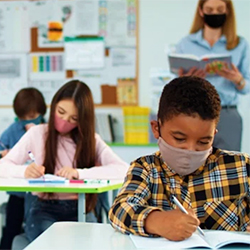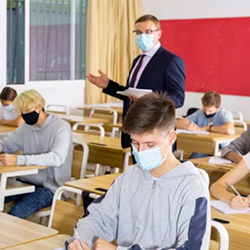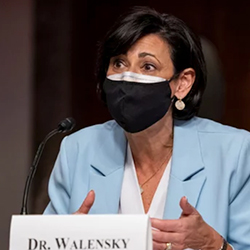By Ethan Covey
School districts that implemented universal mask requirements had COVID-19 incidence rates nearly 25% lower than those without masking requirements, according to a study of schools in Arkansas.
The findings, experts said, provide important context as many areas ease mask guidelines, and may be used to determine effective policies if case rates start to rise in communities (MMWR Morb Mortal Wkly Rep 2022;71[10]:384-389).

“This report is important because it contributes to the body of evidence supporting the effectiveness of masking in K-12 schools,” said Catherine V. Donovan, PhD, an epidemiologist with the CDC COVID-19 Response Team. “The findings suggest that masking in K-12 schools helps to reduce incidence of COVID-19 among students and staff.”
The study looked into COVID-19 incidence among students and staff at K-12 schools in Arkansas from Aug. 23 through Oct. 16, 2021. Masking policies at schools were divided into three categories:
- full (universal masking for all students and staff);
- partial (masks required in certain settings, among specific populations or when criteria such as social distancing could not be met); and
- none (no masks required in school settings).
Of the 233 public school districts included, 30%, 21% and 48% had full, partial or no masking policies when the study began.
Overall, COVID-19 cases were 23% lower in districts that imposed full masking requirements, compared with those without requirements in place during periods of moderate community transmission.
During the study period, 26 school districts switched from having no masking policy to having either partial or full masking requirements. In these schools, incidence fell sharply within one week of introducing masks—faster than predicted by Dr. Donovan and her team. Whereas on average, weekly COVID-19 incidence was higher among students and school staff members than in the general community, they quickly fell to below community levels when masking policies began.
Vaccination was generally low among students and staff members, yet increased from 13.5% to 18.6% during the study period.
“The report is an important addition to the literature because we were able to adjust for both vaccination coverage among students and staff within the school districts and incidence of COVID-19 in the surrounding community,” Dr. Donovan said. “The findings are robust in the sense that we used three different analytic methods with additional sensitivity analyses, and the association of mask policy with lower COVID-19 incidence among students and staff members held across all analyses.”
Dr. Donovan added that the data used in the study were obtained during a period when the delta variant was widely circulating and might not be reflective of the current period of omicron predominance. New investigations, she said, may be beneficial as additional variants arise.
“However,” she added, “we do know that well-fitting masks offer protection against all variants, so these findings reinforce that wearing a mask in K-12 schools is an important prevention strategy in communities where COVID-19 is widely circulating.”



